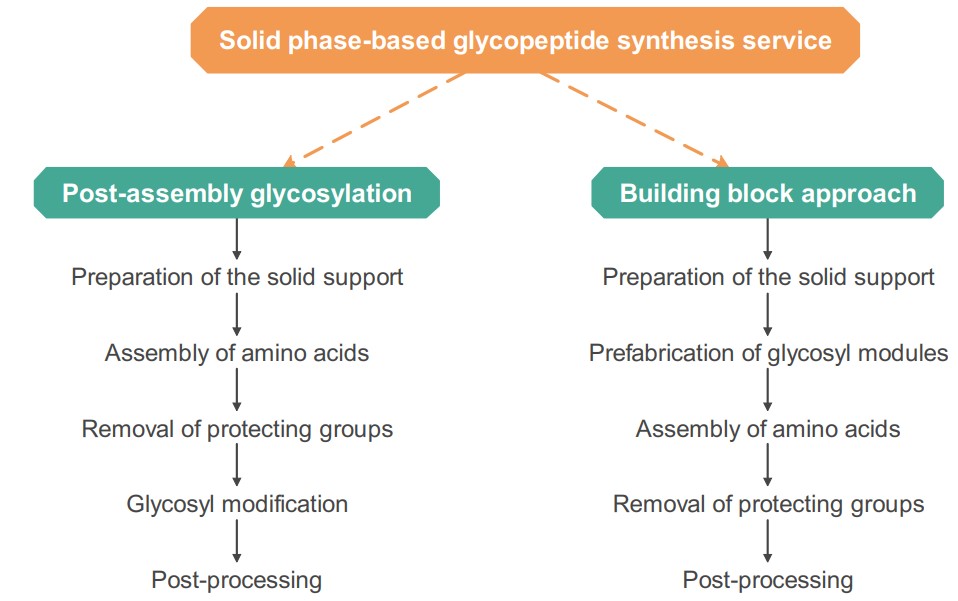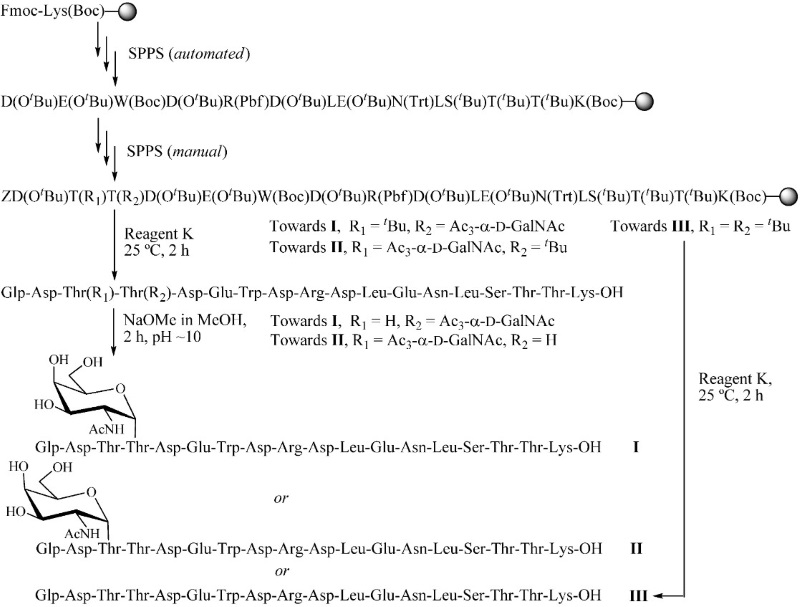Solid Phase-based Glycopeptide Synthesis Service
Professional Solid-Phase Glycopeptide Synthesis Services at Creative Biolabs
There are various linkage types between glycans and designated amino acid residues, such as N-, O-, S-, and C-linkages. Creative Biolabs uses N- and O-glycosylated amino acids as building blocks for standard solid-phase peptide synthesis (SPPS). It is the most common strategic method for the synthesis of glycopeptides, which is used to synthesize small and medium-sized glycopeptide chains containing about 50 amino acids. The synthesis process is fast and simple. We provide different SPPS-based glycopeptide synthesis methods.
Post-assembly glycosylation
-
Preparation of the solid support: We attach the first amino acid to an appropriate solid support (such as a resin).
-
Assembly of amino acids: We gradually add the desired amino acids at the N-terminus through repeated coupling and deprotection steps until a peptide chain of the desired length is formed.
-
Removal of protecting groups: After each round of amino acid coupling, we need to remove the protecting group so that the N-terminus of the newly added amino acid is in a free state for the next round of reaction.
-
Glycosyl modification: After the peptide chain is constructed, we use appropriate glycation reagents to introduce sugar groups into the peptide chain, and choose appropriate protecting groups to protect the reactive functional groups in the sugar groups.
-
Post-processing: After completing the glycosylation reaction, we isolate the target product through mature purification technology, and use mass spectrometry or other technologies to confirm the structure and purity of the synthesized product.
Building block approach
The building block approach is a flexible and efficient method for the synthesis of peptide compounds with specific glycosyl modifications.
-
Preparation of the solid support: We attach the starting amino acids to the solid phase support through appropriate chemical reactions.
-
Prefabrication of glycosyl modules: We design and synthesize appropriate glycosyl modules according to the required glycosyl structure, and use cross-linking agents to connect the glycosyl modules to the peptide chain.
-
Assembly of amino acids: We gradually add different amino acids while adding the appropriate glycosyl modules until the desired peptide chain length is reached.
-
Removal of protecting groups: We push the synthesis reaction forward through the steps of removing protecting groups.
-
Post-processing: After completing the addition of all amino acids, we perform post-reaction processing to ensure the quality and purity of the final synthetic product.

Published data
In this study, the authors adopted a convergent strategy to successfully synthesize three peptide chains of 18 amino acid residues using cross-linked ethoxylated acrylate resin (CLEAR) as a support by combining automated and manual Fmoc solid-phase synthesis techniques. Two peptide chains were associated with the cysteine-rich secretory protein Crisp-1, which plays a key role in fertilization. In addition, during the construction of these peptide chains, the authors used high-performance liquid chromatography (HPLC) combined with electrospray ionization mass spectrometry (ESI-MS) to identify and remove by-products, and comprehensively analyze and identify the final synthesized glycopeptides.
 Fig.1 Solid-phase synthesis of glycopeptides on CLEAR-acid supports.1
Fig.1 Solid-phase synthesis of glycopeptides on CLEAR-acid supports.1
Advantages
-
Professional team: We have experienced and high-quality teams who are familiar with solid-phase synthesis technology and glycopeptide synthesis methods, and they efficiently execute synthesis projects.
-
Mature synthesis technology: We use advanced solid-phase synthesis equipment and mature synthesis technology to quickly complete the synthesis of glycopeptides and deliver products in a timely manner.
-
High-purity products: We ensure product quality through precise synthesis and strict purification steps, providing high-purity solid-phase glycopeptide products.
Application
-
Vaccine development: Glycopeptides play an important role in the field of immunology and serve as vaccine candidates or vaccine adjuvants. Solid-phase synthesis is used to prepare vaccines with specific glycopeptide sequences for activation of the immune system to produce specific antibody responses.
-
Glycopeptide analysis: Solid-phase synthesis is used to prepare glycopeptide standards for calibration and quantification of mass spectrometry, chromatography, and other technologies, which is of great significance for studying the structure, composition, and content of glycopeptides.
-
Bioengineering: Solid-phase glycopeptide synthesis is also used in the field of bioengineering. By synthesizing glycopeptides of specific sequences, new glycopeptide drugs or functional proteins are designed for applications such as biotherapy, cell engineering, and biosensors.
Glycopeptides are important biomolecules, the synthesis of glycopeptides with specific structures is used in drug development, biological activity research, and other fields. Creative Biolabs provides professional Custom Glycopeptide Synthesis services, including solid-phase glycopeptide synthesis and Liquid phase-based Glycopeptide Synthesis. We design personalized glycopeptide synthesis plans according to client needs and flexibly adjust synthesis strategies to meet different project requirements. Please feel free to contact us if you are interested in our glycopeptide synthesis.
FAQ
Q1: What is SPPS?
A1: SPPS is a method for synthesizing peptide chains that are built up step by step from a fixed solid support such as a resin. The process involves repeated amino acid coupling and deprotection steps, allowing the synthesized peptide chain to remain attached to the solid support at each step, making it easier to separate unreacted reagents and byproducts, and improving the purity of the final product. This method is widely applied in biochemistry and drug development due to its efficiency and simplicity.
Q2: What analysis service can you provide to confirm the synthesized glycopeptides?
A2: We provide a variety of analysis services to confirm glycopeptides synthesized by solid phase synthesis, including mass spectrometry (MS) for determining molecular weight and structure, high-performance liquid chromatography (HPLC) for assessing purity and separating impurities, and nuclear magnetic resonance (NMR) for detailed analysis of chemical structure. These techniques are applied in combination to ensure the quality and accuracy of the synthesized products.
Q3: Can I customize the synthesis plan?
A3: Yes, you can communicate with our professional team and describe your specific needs and goals in detail. We will design a personalized synthesis route according to the amino acid sequence, glycosylation type, chain length, and other specific requirements you provide, and flexibly adjust the synthesis strategy to ensure that the final product meets the client's research or application needs. Our team will provide technical support and advice throughout the process to ensure that the synthesis process goes smoothly.
Customer Review
High Efficiency
“I am delighted with the service of Creative Biolabs. The speed of solid phase synthesis of glycopeptides far exceeded our expectations. The post-synthesis post-treatment process is very mature, the process of separating impurities is smooth, and the final product quality is very high.”
Overall Experience
“From consultation to synthesis to post-support, the overall service experience of Creative Biolabs is very good. It is our preferred partner in the field of glycopeptide synthesis.”
Reference
-
Liu, Mian, David W. Hamilton, and George Barany. "Solid-phase synthesis and evaluation of glycopeptide fragments from rat epididymal cysteine-rich secretory protein-1 (Crisp-1)." Molecules 15.9 (2010): 6399-6410. Distributed under Open Access license CC BY 3.0, without modification.
For Research Use Only.
Related Services


 Fig.1 Solid-phase synthesis of glycopeptides on CLEAR-acid supports.1
Fig.1 Solid-phase synthesis of glycopeptides on CLEAR-acid supports.1



